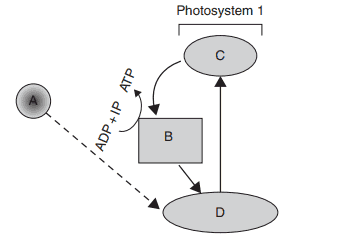1. Where does the primary photochemical reaction occur in chloroplast/Where does the light
reaction of photosynthesis takes place?
a) Stroma
b) Edoplasmic reticulum
c) Quantasome or thylakoids (Grana)
d) Inner membrane of chloroplast
Explanation: Quantasome or thylakoids (Grana)
2. The trapping centre of light energy in photosystem I is
a) P-660
b) P-680
c) P-700
d) P-720
Explanation: P-700
3. What indicates A to D in the given figure?

a) A–e– acceptor, B–Electron transport system, C–Chlorophyll P700, D–Light
b) A–Electron transport system, B–e– acceptor, C–Light, D–Chlorophyll P700
c) A–Chlorophyll P700, B–Electron transport system, C–Light, D–e– acceptor
d) A–Light, B–Electron transport system, C–e– acceptor, D–Chlorophyll P700
Explanation: A–Light, B–Electron transport system, C–e– acceptor, D–Chlorophyll P700
4. Pigment system I conducts
a) Cyclic photophosphorylation
b) Non-cyclic photophosphorylation
c) Both (a) and (b)
d) None of theses
Explanation: Pigment system I conducts both cyclic photophosphorylation and non-cyclic photophosphorylation.
5. Pigment system II is concerned with
a) Photolysis of water
b) Reduction of \[CO_{2}\]
c) Flowering
d) None of theses
Explanation: Pigment system II is concerned with photolysis of water.
6. Photophosphorylation is a process in which
a) Light energy is converted into chemical energy in the form of ATP.
b) NADP is formed
c) Chemical energy is used to produce ATP
d) \[CO_{2}\] is reduced to carbohydrate
Explanation: Photophosphorylation is a process in which light energy is converted into chemical energy in the form of ATP.
7. The reaction centre for PS I and PS II are
a) \[P_{700}\] and \[P_{680}\] respectively
b) \[P_{680}\] and \[P_{700}\] respectively
c) \[P_{580}\] and \[P_{700}\] respectively
d) \[P_{700}\] and \[P_{580}\] respectively
Explanation: \[P_{700}\] and \[P_{680}\] respectively
8. Results of light reaction is/are
a) Only ATP
b) Only \[ NADPH_{2}\]
c) ATP and \[ NADPH_{2}\]
d) Only FAD
Explanation: Results of light reaction is/are ATP and \[ NADPH_{2}\]
9. Biosynthetic phase of life uses all except _________ that is produced in photochemical phase.
a) ATP
b) NADPH
c) \[O_{2}\]
d) None of theses
Explanation: Biosynthetic phase of life uses all except \[O_{2}\] that is produced in photochemical phase.
10. If light is available for a given duration and then again made unavailable, the biosynthetic
process will
a) Continue for long duration
b) Continue for unlimited time
c) Continue for short duration
d) Will stop immediately
Explanation: Continue for short duration